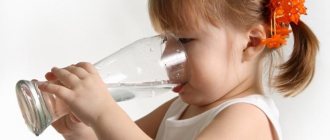What is diarrhea
With repeated excretion of stool in liquid form, doctors diagnose diarrhea. This is not an independent disease, but a symptom characteristic of pathologies of the intestines, stomach or pancreas. He indicates to the specialist that the person has had a disruption in the natural process of water absorption into the rectal mucosa, and destruction of the bonds between electrolytes.
In the absence of health problems, the child’s body excretes up to 100–150 grams of feces daily. The norm is approximate and depends on the diet, appetite and age of the baby. With diarrhea, nutrients do not have time to be absorbed into the epithelium, the flow of water into cells and tissues decreases: accelerated peristalsis removes them out, creating dangerous dehydration.
Liquid green stool is conventionally divided into two subspecies. Acute diarrhea lasts no more than 2 weeks and accompanies the infection. In the chronic form, greenish-colored feces are released in a volume of at least 300 grams per day, and the number of visits to the toilet reaches 6–8 times. In this case, a sign of a serious disorder is a large number of undigested pieces of food.
Abnormal bowel movements that are not cause for concern
In the first months of life, the functioning of the gastrointestinal tract is far from ideal, so rare watery stools in an infant are not considered a pathological phenomenon. Quite often there is stool disorder in breastfed babies. Liquid green stool in a newborn may be due to the fact that a nursing mother's diet contains a large amount of raw plant foods. In this case, following a certain diet will help normalize stool. A young mother should give up not only a large amount of green vegetables and fruits.
Also excluded from the menu:
- smoked meats;
- sweet sparkling water;
- fatty foods;
- chocolate;
- hot and spicy dishes.
All these products have a harmful effect not only on the mother’s body, but also on the child’s body. That is why infants fed with breast milk may experience dysbiosis and, as a result, the appearance of greenish stool.
Even those babies who eat artificial formulas are not immune from unpleasant symptoms of intestinal upset. Another factor that can cause diarrhea with greens in a child is the high iron content in the formula intended for baby food.
Iron is an essential trace element for maintaining the normal functioning of the entire body, however, due to the insufficient development of the intestinal tract, it may simply not be absorbed in infants, turning the stool an unnatural color. In this case, choosing a different product will help cope with diarrhea. It is best to make a purchase after consulting with a pediatrician.
Green-colored stool often appears during the period when parents switch the baby to natural complementary feeding. The intestines may simply not be able to cope with the new food entering the stomach. This situation is especially common if too little time passes between adding new foods to the diet (the recommended pause is 3 or 4 weeks). Another factor that provokes intestinal upset is the untimely introduction of complementary foods.
To prevent watery green stools, you should not introduce complementary foods if:
- the baby's body weight has not doubled since birth;
- during feeding, the baby pushes the spoon out with his tongue and shows no interest in adult food;
- The child cannot sit up or turn his head independently.
Quite often, bowel dysfunction is observed in children aged 3 years and older. At 4 years old, the child does not need breast milk and already eats plant foods, a large amount of fruits and berries. Despite all their benefits and rich vitamin composition, such products can be poorly absorbed, which will lead to loose stools of a color uncharacteristic for a healthy person.
Light green stool indicates a mild intestinal infection, while dark green stool is a sign of salmonellosis.
Another cause of diarrhea may be long-term treatment with antibiotics. Potent antibacterial drugs have a detrimental effect on pathogenic microflora, simultaneously killing bacteria necessary for normal digestion. By rapidly multiplying, pathogenic microflora interferes with the normal absorption of vitamins and microelements, so the resulting dysbacteriosis cannot be ignored.
The general condition of the baby plays a major role in making a preliminary diagnosis. If the child is active, plays and does not cry, most likely severe intoxication has not affected his body, and greenish diarrhea is a manifestation of a slight digestive disorder.
Causes of green diarrhea in children
Green diarrhea in a child begins suddenly and may be accompanied by complaints of abdominal pain, vomiting and other unpleasant symptoms. In most cases, the cause is hidden in infection with different types of pathogens:
- pathogenic fungi (yeast),
- bacteria,
- enteroviruses.
Such species provoke the development of intestinal infections associated with the activity of staphylococci, streptococci, and Pseudomonas aeruginosa. Upon contact with the intestinal mucous membranes, their active reproduction begins. They not only change the acidic environment of the epithelium, but also provoke the death of beneficial microflora, which is unstable in infancy.
Dysbacteriosis
Green diarrhea in children of the first year of life often occurs due to intestinal dysbiosis. The disease is increasingly being diagnosed in bottle-fed babies. It is associated with an imbalance of microflora and a significant increase in colonies of pathogenic microorganisms. At this age, the causes of pathology and diarrhea are as follows:
- improperly selected nutrition,
- allergy to milk proteins,
- antibiotic treatment.
In this case, the child’s green, loose stool is replaced by prolonged constipation, problems with bowel movements, and painful spasms. The disease can only be determined by a special stool analysis for the level of bifidobacteria, lactobacilli, and their concentration in the rectum.
Staphylococcus aureus
The dangerous bacterium is very common in the environment. It settles on the mucous membranes of the nose, genitals, and penetrates the intestines through the anus or esophagus. It is easy to infect a baby with daily care, during breastfeeding, or during the passage of the fetus through the birth canal. If a child has green diarrhea without fever, peeling or a rash on the skin of the abdomen, the pediatrician may refer you for stool tests.
The bacterium gradually infects the child’s internal organs and parasitizes their membranes. It is difficult to destroy by boiling or freezing. But its presence in the body negatively affects well-being:
- the child has diarrhea with greens several times a day,
- immunity is greatly reduced,
- food is practically not digested,
- there is a lack of vitamins and minerals.
These factors create conditions for frequent colds and disrupt the harmonious growth and development of the child. Treatment of the disease is long-term and requires a careful approach and constant monitoring by an immunologist or gastroenterologist.
Introduction of new complementary foods
If a child has dark green diarrhea, the doctor asks the parents to list the diet and inquires about the baby’s daily menu. Often the cause of the painful condition lies in the parents’ violation of the rules of complementary feeding. This reaction of the body occurs to the following types of products:
- whole cow's milk,
- fatty meats or fish,
- Exotic fruits,
- nuts.
The problem is related to digestive disorders: many enzymes begin to be produced only after 3 years, the intestines cannot process new foods and fats. Liquid green stool in a child becomes a sign that the digestive system cannot cope with complementary foods; a reduction in portions or the selection of lighter ingredients is required.
In rare cases, dark green diarrhea in a child occurs due to liver pathologies, blockage of the hepatic ducts, or internal bleeding. When blood is excreted in the stool, it gives an atypical shade, black spots. Therefore, any changes in the baby’s stool or the appearance of white diarrhea is a reason to seek advice from a specialist.
Acute intestinal infections
ACI (acute intestinal infections) is a group of infectious diseases (about 30 types) that are caused by various pathogenic microorganisms (viruses, protozoa, bacteria); affect the gastrointestinal tract.
CAUSES
The following reasons lead to the appearance of acute intestinal infections:
- Contact-household infection - contact with an infected person, with a carrier of the pathogen (animal, human);
- Food contamination - ingestion of contaminated food: meat, raw water, milk, cream confectionery, unwashed vegetables, fruits and berries;
- Through contaminated household items, dirty hands;
- Swimming in polluted waters.
CLASSIFICATION
Types of intestinal infection:
- Dysentery (shigellosis);
- Rotavirus intestinal infection;
- Staphylococcal food poisoning;
- Cholera;
- Salmonellosis;
- Intestinal yersiniosis;
- Typhus;
- Paratyphoid;
- Escherichiosis.
By type of diarrhea:
- Invasive type (exudative diarrhea, liquid) - caused by bacteria: clostridia, shigella, Pseudomonas aeruginosa, salmonella, etc.;
- Secretory type (watery diarrhea without flatulence) - caused by bacterial flora: Vibrio cholerae, Campylobacter, enterotoxigenic Escherichia;
- Osmotic type (watery stools with flatulence) - formed by viruses: adenoviruses, rotaviruses, coronoviruses and others;
- Mixed type: invasive-secretory, invasive-osmotic.
Symptoms of diseases
Clinical manifestations depend on the type of intestinal infection:
- Shigellosis: the incubation period (the moment from the penetration of the pathogen into the body until the appearance of the first clinical signs) is 24–48 hours, fever (40° and above), and watery diarrhea up to 10-30 times a day are observed. The stool contains mucus, blood, and in rare cases, pus. Pain in the abdomen of a cramping nature. A painful urge to defecate (tenesmus), discomfort in the anal area;
- Rotavirus intestinal infection: the incubation period is up to 5 days, the disease is characterized by fever, repeated vomiting, in the first days the stool is yellow, then becomes gray-yellow, with a clay-like consistency. In addition, the patient is bothered by a sore throat, rhinitis (runny nose), cough;
- Staphylococcal food poisoning: the first clinical signs appear 2-4 hours after infection, intense cramping pain in the epigastrium, repeated vomiting, hyperthermia (38–38.5°) are observed. Chills, cold extremities, low blood pressure are noted, diarrhea occurs in 50% of cases;
- Cholera: the incubation period is 1-6 days, the disease is characterized by watery diarrhea, which after a couple of days takes on the appearance of odorless “rice water”. The patient has profuse vomiting (“fountain”), dry mouth, hoarseness, possible drop in body temperature to 35.5–36°, cramps of the calf muscles (involuntary contractions), cyanosis of the lips and fingers;
- Salmonellosis: the disease manifests itself 6 hours or 2-3 days after the infection enters the body. An infected person experiences an increase in temperature to 39 degrees, dyspepsia (nausea, vomiting), cramping pain in the abdomen, green, watery, foul-smelling loose stools. On days 2-3, mucus and blood are present in the stool;
- Intestinal yersiniosis: incubation period from 15 hours to 6 days, manifests itself with fever (39°), rhinitis, sore throat, lacrimation, cramping pain syndrome. There are muscle pains, dry skin, a pinpoint rash appears, the palms and feet are pasty (swelled), the tongue has a crimson color;
- Typhus: the incubation period is 12-14 days, the disease is characterized by fever (up to 39°), excitability of the patient (mobility, talkativeness). The face becomes hyperemic (red), puffy (edematous), small hemorrhages are present on the conjunctiva of the eye, the tongue is dry, covered with a dirty gray coating. The skin is dry, hot; typhus exanthema (rash) forms;
- Paratyphoid fever: the disease manifests itself after 14 days and is characterized by rhinitis, cough, and facial flushing. Dyspepsia (nausea, vomiting), diarrhea, herpetic rashes (papules with contents) are noted;
- Escherichiosis: the first signs of the disease begin to appear after a few hours. On the 2nd day, liquid, spattering yellow or orange stools up to 15–20 times a day, bloating, rumbling, vomiting up to 5 times a day, hyperthermia (37–39°) are noted.
Oki in children
Acute intestinal infections in children develop for the same reasons as in adults. Children under 3 years of age are most susceptible, as their immune system is not strong enough.
OCI in children manifests itself with a pronounced clinical picture and occurs in a more severe form than in adults. The peak incidence occurs in the summer. Intestinal infections in children manifest themselves in the form of intoxication of the body (general weakness, fever, loss of appetite).
Symptoms of damage to the digestive system:
- Pain syndrome in the epigastrium of a cramping nature;
- Repeated vomiting;
- Frequent loose stools;
- Headache;
- Fever;
- The stool is most often green and may contain blood;
- The skin is dry, the eyes are sunken;
- Dyspepsia;
- Thirst;
- lacrimation;
- The tongue is dry, covered with a thick white coating;
- Rare, scanty urination;
- Dehydration of the body;
- Convulsions;
- Loss of consciousness.
Treatment methods
When symptoms of OCI appear, it is necessary to provide first aid and then be sure to consult a doctor who will prescribe an individual course of treatment.
First aid
An infected person should be given first aid:
- Isolate the infected person from others;
- The patient should be given drinks in small quantities, but often; moisten your lips with a napkin soaked in water;
- Lay on one side; if there is vomiting, place a container;
- Unbutton, remove tight clothing;
- Ventilate the room;
- Apply ice wrapped in a cloth or a wet, cold bandage to the head;
- You cannot give food or do cleansing enemas;
- It is forbidden to apply a heating pad or give medications (painkillers, astringents, antipyretics).
All children, regardless of age, are subject to hospitalization; adults - with moderate and severe forms of infection.
For any intestinal infection, gastric lavage is mandatory. It is prescribed regardless of how much time has passed since the onset of the disease, since the pathogen can remain viable for a long time on the walls of the gastrointestinal tract.
Drug treatment
- Detoxification therapy: oral administration (through the mouth) of glucose-salt solutions: rehydron, citroglucosalan, glucosalan. Adults: 30 ml/kg/day, children: 30–50 ml/kg/day;
- Sorbents – remove toxins from the body: activated carbon, polyphepane, smecta
Smecta, 1 sachet diluted in ½ cup of water (50 ml of liquid), taken 3 times a day;
- Intestinal antiseptics - destroy pathogenic microflora: enterosidiv, intetrix, intestopan
Intetrix, 2 capsules 2 times a day;
- Antidiarrheal drugs: chloramphenicol, enterosgel, imodium
Imodium, initial dose 2 tablets, then one tablet after each bowel movement, maximum daily dose 16 mg (8 tablets);
- Probiotics – to restore normal intestinal microflora: acipol, acylak, linex
Acipol, 1 capsule three times a day;
- Prebiotics are carbohydrates that feed “good” microorganisms: hilak-forte, lazozyme
Hilak-forte, 40–60 drops three times a day;
- Enzymatic preparations - to improve the functioning of the digestive system: Creon, Mezim, Pancreatin
Creon, 1 capsule per day;
- Antibacterial agents: tetracycline, ceftibuten, penicillin.
Ceftibuten, 1 capsule per day.
ethnoscience
For AEI, the following traditional medicine recipes are used:
- 20 gr. peppermint leaves, 15 gr. fennel fruits and calamus root, 30 gr. daisies. Grind the ingredients, 1 tbsp. Brew a spoonful of the prepared mixture with a mug of hot water. Take 1/3 cup three times a day;
- 40 gr. oak bark, pour a liter of boiling water, simmer for 10 minutes over low heat. Cool, take ½ cup 6 times a day;
- For a liter of boiled water, 8 teaspoons of granulated sugar and ½ teaspoon of soda, 1 cup of orange juice, a teaspoon of salt, drink throughout the day.
DIET
Meals for acute intestinal infections should be divided, at least 5 times a day, enriched with vitamins, microelements, proteins and fats. It is important to drink pure liquid, at least 1.5 liters per day.
Authorized products:
- Dairy products;
- Lean meat;
- Inconvenient pastries, dried out bread;
- Cereals, cereals;
- Vegetarian soups;
- Pasta;
- Dried fruits;
- Vegetables, berries, fruits;
- Butter;
- Rosehip infusion, fruit drinks, tea and coffee with milk.
Prohibited products:
- Baking;
- Semi-finished products;
- Canned food;
- Fatty meat, fish;
- Smoked, salted, marinated dishes;
- Legumes;
- Mushrooms, cabbage, onions, garlic;
- Spices, herbs;
- Chocolate, products with cream (cake, cake);
- Carbonated and alcoholic drinks.
COMPLICATIONS
Acute intestinal infections can cause the following complications:
- If left untreated, serious consequences can occur! Dehydration (dehydration);
- Infectious-toxic shock;
- Pneumonia;
- Acute renal failure;
- Death.
PREVENTION
Preventive measures include:
- Drinking boiled water;
- Washing vegetables and fruits;
- Compliance with personal hygiene rules;
- Short-term storage of perishable products;
- Heat treatment of food before consumption;
- Home cleaning;
- Do not swim in polluted waters.
Source: https://krdgp25.ru/patsientam/poleznaya-informatsiya/shkola-zdorovya/ostrye-kishechnye-infektsii/
Symptoms and dangers of green diarrhea in children
Many parents self-medicate, trying to normalize the baby’s condition with medications of their own choice. Therefore, diarrhea threatens to develop into a chronic form. To prevent inflammation, you need to pay attention to the following symptoms:
- the child has diarrhea with greens,
- I have a stomachache,
- the baby twists its legs, presses them to the navel,
- anxious and short sleep gives way to hysterics,
- vomit,
- temperature rise above 38°.
The presence of mucus indicates the development of an intestinal infection; rashes often appear with food allergies. Any symptoms require careful observation and mandatory treatment. Dark green diarrhea in a child can provoke the development of severe complications:
- Excessive loss of fluid during loose stools can lead to dehydration. This dangerously increases blood density and negatively affects the functioning of the brain, cardiovascular system, and kidneys.
- If food is not digested well enough, the body does not receive enough nutrients. The baby becomes lethargic, drowsy, and lacks energy for games, communication, and learning new knowledge.
- Growth slows down and weight loss begins.
Why green diarrhea in a child should be determined by a doctor. The task of parents is to correctly describe all the symptoms that accompanied the inflammatory process, to indicate factors that could affect the consistency and shade of the discharge.
Diarrhea with black mucus
Sometimes diarrhea with mucus in a small child under 3 years of age is dark brown and sometimes black in color. This happens if the baby took activated carbon the day before, or is taking a course of taking certain vitamin-mineral complexes that can give such coloring.
If the baby is not yet a month old, his stool may be dark in color and runny in consistency, resembling diarrhea with mucus. In the first week after birth, this is a normal occurrence in an infant, as the baby passes meconium - the original feces, which is a dark mass.
However, in some situations, black feces indicate serious disturbances in the functioning of the body caused by internal bleeding:
during the oncological process; for peptic ulcer of the stomach and duodenum; for polyps; with dilated veins of the esophagus.
In addition to dark stool, the child has other symptoms that indicate a pathological process. These are complaints of lethargy, weakness and headaches. Anemia can also be detected in a blood test, which is often accompanied by pale skin and dizziness. If you notice any of the above signs, you should consult a doctor. To identify hidden internal bleeding, colonoscopy and FGDS are performed.
How to provide first aid to a child
If a child has green diarrhea and fever, it is necessary to call an ambulance to alleviate the baby’s condition as follows:
- Rinse the stomach with clean water at room temperature, induce vomiting by pressing on the base of the tongue.
- If there is no vomiting, give clean water without gas.
- Avoid any foods, milk, or sweets until consulting a doctor.
- A one-year-old child is given a light formula of no more than 50 ml at a time, being careful not to overload the stomach.
- At temperatures above 38°, you can give a dose of Paracetamol or Ibuprofen.
- Wipe the baby with water, moisten your lips more often.
It is possible to select a more precise treatment only after tests for microflora, staphylococcus, and ultrasound of internal organs. It is necessary to exclude gastric bleeding, an attack of appendicitis or severe indigestion.
Change in stool color
If a child has green diarrhea with mucus, this is most likely the result of poisoning. When a baby eats a low-quality product, the body first reacts with acute abdominal pain and nausea, and a little later green diarrhea begins.
This shade of stool can also appear as a result of weakening of the body after prolonged use of antibiotics. Such babies are easy prey for infections.
In addition to inclusions or green mucus, this case is characterized by high fever and vomiting.
Diarrhea with green mucus can occur in children who have impaired enzymatic function. That is, the body secretes few enzymes to break down food. This is possible, for example, with chronic pancreatitis. Additional characteristic signs are flatulence and increased fatigue.
If the cause of diarrhea is dysentery, then in addition to green mucus, a small amount of blood may be present in the stool. Such patients are characterized by weakness, urge to vomit, and acute abdominal pain. The child is restless, rushes about, and is capricious.
The color of stool, as with dysentery, may be normal for a newborn. This color of stool is due to the still unstable functioning of the gallbladder.
Yellow diarrhea in infants and children up to one year old may be normal. But the sudden appearance and prolonged presence of such a sign may indicate the presence of rotavirus infection. Other characteristic symptoms of this pathology: a sharp and significant increase in temperature, general malaise, vomiting. The infection also affects the mucous membrane of the respiratory tract, so the child also develops typical signs of a respiratory disease (nasal congestion, sore throat, runny nose, cough).
Yellow diarrhea is also called “straw” diarrhea. It is provoked by an RNA virus that enters the body through airborne droplets from the person who is the carrier. This can happen, for example, if an infected patient does not wash their hands after using the toilet and touches a child or an object with which the child subsequently comes into contact.
Such an infection is dangerous due to rapid dehydration, and there is an impressive percentage of deaths. In case of effective treatment, the symptoms are eliminated and the water balance is restored. However, a young patient develops a rather unstable immunity, which increases the risk of re-infection.
Features of the treatment of green diarrhea in children
Vomiting and green diarrhea in a child can lead to dehydration, so it is necessary to monitor the condition and well-being. In newborns, when the water balance is critically low, the “fontanel”, an unossified area on the top of the head, begins to sink. Blood vessels appear in it, their pulsation becomes noticeable.
How to treat green diarrhea in a child depends on the situation and symptoms:
- For intestinal infections, special antibiotics are needed: Enterofuril, Loperamide.
- To reduce intoxication, sorbents are recommended: Polysorb, activated carbon, Atoxyl.
- To eliminate dehydration, it is necessary to give a small portion of special drugs for rehydration every 15–30 minutes: Regidron, Reoxolan, Glucosolan.
- Green diarrhea and fever are very debilitating, so you can give antipyretic drugs 2 times a day: Panadol, Paracetamol, Nurofen.
Dysbacteriosis requires the use of special agents that normalize the microflora. If a child's green diarrhea without fever was caused by the development of this disease, for several weeks the baby should be given Linex, Bifidumbacterin, Acipol, Biobakton, Bifiform, and fermented milk mixtures from medicinal series should be introduced into the diet.
Prevention
Prevention of green diarrhea in children involves regular adherence to the following activities and actions.
- A nursing mother should follow a diet and, if possible, not take antibiotics.
- If your child is bottle-fed, consult your doctor about which formula is best to choose.
- Introduce complementary foods gradually. If green diarrhea is a reaction to a certain product, it is better to exclude it from the child’s diet for now and wait until the gastrointestinal tract is more fully formed.
- At an older age (after 3 years), normalize the child’s diet: there is no need to overfeed him with carbohydrates and greens.
- Adults should not lick baby's spoons or pacifiers. They can give him an intestinal infection with their saliva.
Have you noticed that your child has green diarrhea? In this case, first try to find out its cause, and then take some action.
The best option would be to consult a doctor at the slightest suspicion of health problems. This will reduce the risk of complications and allow you to be treated quickly and without consequences. And to prevent this from happening again in the future, you need to regularly engage in prevention.
Green baby diarrhea worries his mother. Not all parents know that it can mean green. There may be several factors causing green diarrhea.
Nutrition for diarrhea
If you have indigestion, you should choose a light and balanced diet. All food should be in the form of a light puree without butter or sour cream. Fats, sweet desserts, and any foods that can increase fermentation in the intestines are temporarily excluded: smoked foods, cabbage, yogurt, and baked goods. The best options to reduce green diarrhea with mucus in a child:
- steamed chicken meat, ground into pate,
- boiled vegetables (potatoes, carrots, broccoli),
- steam omelettes and soufflés,
- rice or oatmeal porridge,
- low-fat broth,
- egg yolk.
After a period of exacerbation with diarrhea, the child’s diet is supplemented with baked vegetables and fruits, fermented milk products, jelly or fruit juice from seasonal berries are gradually introduced. Instead of sweets, dried bread, bagels or crackers are allowed.
When to sound the alarm
One of the dangers for a fragile child’s body is intestinal infections. Dirty hands are not always the source of infection. The food a child eats must be heat-treated. Fruits and vegetables should be washed thoroughly with hot water. The products that make up the baby’s diet must be of the highest quality.
Loose stools with dysentery are not the only symptom of infection. If you eat low-quality foods, for example, eggs contaminated with salmonella or fish that has not undergone sufficient heat treatment, diarrhea with mucus and blood may occur. Other symptoms of severe intoxication are frequent vomiting and fever up to 38 degrees or more. The child complains of pain localized in the epigastric region, which subsequently spreads throughout the abdomen, giving way to cramping pains. This condition is dangerous for a child’s sensitive body, therefore, if they notice at least one symptom of poisoning (especially in an infant), parents should immediately call an ambulance.
In addition to infection by viruses and bacteria, a child can be poisoned by their waste products, for example, by eating a product that has expired or was stored without sanitary standards. Infectious agents are also able to enter the body when a child comes into contact with a sick peer.
Signs of dysbiosis in infants
Another situation in which an early consultation with a doctor is required is the appearance of greenish stool in a newborn baby. A similar symptom may be a sign of a food allergy:
- lactase deficiency;
- maltose intolerance;
- sucrose deficiency.
Green diarrhea in the case of a lack of digestive enzymes is due to the fact that the gastrointestinal tract is not able to break down food into easily digestible substances.
To prevent food poisoning, parents should carefully monitor the expiration dates of the products consumed by their child.
Traditional methods and recipes
Green diarrhea in a one-month-old baby should be treated only under the supervision of a specialist. For school-age children, taking medications can be supplemented with traditional methods. At home, Regidron for dehydration is replaced with the following composition:
- 0.5 l of boiled water,
- 15 grams of sugar,
- 10 g salt.
After stirring, the composition is drunk in small portions of 100 ml at intervals of 20–30 minutes. Useful plants from which it is recommended to prepare a decoction for drinking against diarrhea:
- oak bark,
- pharmaceutical camomile,
- blueberries,
- flax seeds,
- chicory.
To restore balance in the intestines, children can be given rice water or jelly. It absorbs dangerous toxins, relieves irritation and spasms, and has a pleasant taste.
Diagnostics
One of the informative diagnostic methods for identifying the cause of intestinal disorders in children is coprogram. This analysis helps to establish the presence of dysfunctional disorders of the enzymatic system, analyze the quality of the pancreas, detect areas in which the functioning of the gastrointestinal tract is impaired, and indicate the severity of the pathology.
The doctor also prescribes a stool test to identify dysbacteriosis. It is effective in determining the type of microbes that provoked digestive disorders. This helps to choose the right and effective treatment method. As a result of this analysis, it is possible to detect damage to the body by parasites such as staphylococcus, enterococcus, Klebsiella and Proteus.
The doctor necessarily prescribes a study, during which the sufficiency or deficiency of lactobacilli colonies in the intestines is determined. It takes a very long time to wait for results, up to a week and a half.
How to treat?
With infectious diarrhea, the child has green diarrhea and fever. In such cases, antibiotic therapy is usually prescribed. Also, children are often prescribed drugs from the group of enterosorbents, for example, Smecta or Polysorb. They will help delay the absorption of toxins from the intestinal lumen into the blood, which will alleviate the baby’s condition. When the body temperature rises above 38 degrees, children are prescribed antipyretic medications (Paracetamol or Nurofen in syrup).
Ideally, the patient should be in an infectious diseases hospital, where he can be given an accurate diagnosis, determine the cause of the disease and select treatment according to his age. Within the walls of the hospital, children can be provided with parenteral nutrition to relieve the gastrointestinal tract during the period of illness, and the hospital regimen and diet will speed up recovery.
In case of dysbacteriosis, diarrhea can be treated at home. After consulting with your local pediatrician, you can take a course of pre- or probiotics. Currently, the pharmaceutical market offers a wide selection of these drugs. Your doctor will advise you which one to choose. Treatment usually takes at least 30 days and should not be carried out while taking antibacterial drugs.
Prebiotics differ from probiotics in that they do not contain “good” bacteria, but rather provide an optimal environment for these bacteria. Probiotics are portions of “good” microbes.
To prevent diarrhea associated with poor diet, it is necessary to follow the rule that states that the introduction of new and previously unfamiliar foods into the baby’s diet should occur gradually. You should start introducing your baby to new food with small volumes, for example, give him a teaspoon of this product, after a few days increasing the portion by 2 times. You should not feed your children fatty fried foods.
Causes
Causes of green diarrhea:
dysbacteriosis; intestinal infection; liver diseases; intestinal bleeding (rare).
Green-colored diarrhea appears in many newborns in the first days after birth. There is nothing dangerous in this, since meconium, the original feces, will be excreted from the child’s body over the course of several days.
In older children, green diarrhea is often a consequence of intestinal infections. In this case, the temperature may rise, weakness and abdominal pain, nausea and vomiting may occur. These are characteristic symptoms of intoxication of the body by pathogenic microflora - protozoa, viruses, bacteria and fungi. Read more about these symptoms →
Similar symptoms of green diarrhea occur in a child against the background of liver disease, only discomfort in the epigastric area and right hypochondrium may be added to them.
Dysbacteriosis is characterized by loose, greenish stools, with the presence of mucus and streaks of blood in advanced cases. In this case, diarrhea may periodically give way to constipation.











